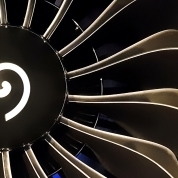
-
Content Count
3,937 -
Donations
$275.00 -
Joined
-
Last visited
Community Reputation
3,070 ExcellentAbout JRBarrett
-
Rank
Member - 3,000+
- Birthday 11/09/1955
Profile Information
-
Gender
Male
-
Location
Elmira, NY
-
Interests
Aviation - Computers - Sailing - Golf
Flight Sim Profile
-
Commercial Member
No
-
Online Flight Organization Membership
VATSIM
-
Virtual Airlines
Yes
Recent Profile Visitors
11,017 profile views
-
I am doing my first long flight (KELM to KLNK) with ASFS and I am very pleased with the cloud variety I am seeing. On climb out from KELM the clouds were flat stratus about 4000 feet thick, As I traveled further west, they changed to a base stratus layer with cumulus buildups here and there rising up through the lower layer. It is something I don’t think I have seen before with default Live Weather, but something I have seen often on real flights, and it looks very good. Winds aloft at FL340 are spot on. They correspond almost perfectly with the predicted winds aloft at enroute waypoints on my Simbrief flight plan. Not surprising, because both Simbrief and ASFS are using wind predictions from the GFS model. Temperatures aloft are also very close to the Simbrief predictions. I see the ASFS configuration menu has options to set the maximum surface and aloft visibility but I don’t think that is working yet. I have the maximum aloft visibility set to 60 miles, but it appears to be unlimited above the clouds, as it is in default Live Weather. I am monitoring several simconnect weather variables with the SDK “Simvar” utility, and the “Ambient Visibility” parameter is fixed at 84.84 miles. I am now traveling over central Ohio and the clouds have changed to scattered cumulus, but there is no volcanic ash look to them. The real-time current visible satellite image for my aircraft location shows the cloud depiction is accurate.
- 836 replies
-
- 11
-

-

-
ATIS reports use simconnect weather variables. There are variables for temperature, pressure, wind speed and direction and visibility, but there is no variable for dewpoint. There has never been a DP variable in the entire history of the MS franchise, nor is there DP in P3D simconnect, which is derived from MS ESP. It is probably high time that they did add such a variable to simconnect, at least for the purposes of accurate ATIS reports. I am quite sure that the MB weather model does contain several parameters relating to atmospheric moisture, including dewpoint, humidity and saturation mixing ratio, and those parameters are likely used it setting the actual injected weather.
-
I think they understand perfectly well what people want in terms of historical weather, but since providing that would be an absolute impossibility the way that Live Weather is currently designed, they are probably not interested in pursuing a conversation on the matter. No matter how much people might want it, there is no way they can ever provide it. The exception would be the thing I mentioned at the end of my post. Each model run does contain data for one full day, and it would probably not be too difficult to stream forecast data for the local time that a user has set within MSFS, rather than the current GMT time. A complication though would be getting the appropriate METAR data for other than the current GMT time.
-
Historical weather would be an impossibility in MSFS native Live Weather which is based on a model created by MeteoBlue. The model contains data for the entire atmosphere of the earth, from the surface to the stratosphere, and is available to any MSFS client. The entire model is not streamed to end-users - only the data that applies within a certain radius of the user’s current location, but the entire model does “live” on the Azure servers. I don’t know how large the entire NEMS 30 global model is, but based on work I have done with the NOAA GFS model (outside of flight simulation) it is probably many many gigabytes in size. Let us assume for the sake of argument that a single model run is 30GB in size. It’s not that MeteoBlue does not have archives of previous model runs - I am sure they do, going back many years. But consider what would have to happen if a single MSFS user wanted historical weather data for a specific date - say January 16th 2017. Azure would have to reserve space on their servers for 30 GB of data, then put in a request to MeteoBlue to stream the entire 16JAN17 model run to Azure. That model would then have to be post-processed to put it into a form that MSFS can use. All this to suit the needs of a single MSFS user looking for historical weather! Multiply that by hundreds of of MSFS clients all asking for historical weather for different dates, and you can see the problem. Even if Azure has virtually unlimited storage space to hold model data, I doubt that MeteoBlue has the capacity to support constant “pull” requests for historical model data. And who would pay for that? I imagine that the contract between Microsoft and MeteoBlue specifies that MB will provide “x” number of model updates to Azure each day for a certain price. There would be no provision for constant, unending requests for model data for previous runs. Historical METAR data is another matter, and there would be no problem for a weather engine based ONLY on METAR to obtain that. Historical METARS are readily available from the NOAA and other sources, and are supplied in the form of a simple text file, which in compressed form would probably be only a few dozen kilobytes in size. Current or historical GFS model data from the NOAA can also be pulled from https://nomads.ncep.noaa.gov but typically clients who do that are not receiving the entire worldwide model, but a limited subset of model data in GRIB format, covering a particular geographic location. The file sizes are typically quite small. X-Plane does this for providing current winds aloft data from the GFS model LiveWeather using MeteoBlue worldwide model data was simply never designed or intended to support historical weather. It is not that Microsoft does not recognize why customers would want this feature, but they made a design decision on how the MSFS weather system was going to work in the early stages of the sim’s development that precludes any possibility of providing historical weather data. That said, it might be possible to provide data for other than the current time within a particular day, since a single model run should contain worldwide forecast data for 24 discrete one hour periods. That would probably suit the needs of MSFS pilots who simply want weather appropriate to the location and time of day they are flying. Perhaps they might implement something like that in FS2024.
-
The problem with dewpoint is that there is no simconnect weather variable to store a value for “dewpoint”. There never has been such a variable in an MS-derived sim including P3D and FSX. In the case of MeteoBlue based LiveWeather, dewpoint probably exists internally in the model data and can be used in weather scenario creation, but there is no place to “put” the value so that it can be used by external apps via simconnect.
-
MSFS Live Weather (not manual) definitely can display true stratus. I have seen it several times when flying in Southern California when there is a marine layer cloud deck offshore. Flat bottoms, flat tops, and 100 percent coverage. Live Weather doesn’t “do” stratus as often as it should, but it is capable of it.
-
Yes. The winds aloft come from (most likely) the GFS grib. They do not come from METAR.
-
Many people have complained that MSFS Live Weather never seems to generate a true stratus layer. You are complaining because ASFS has created what appears to be a very realistic looking stratus layer! There is nothing “horrible” about it. Those kinds of flat layers (that look exactly like your screenshot) occur all the time - especially right offshore in Southern. California at this time of year. Now, your photo shows the real clouds at that time are stratocumulus. One problem with using METAR to generate clouds is that METAR normally contains absolutely no information as to what exact kind of cloud layer might exist with an observation of OVC (overcast). The only time the type of cloud might appear in a METAR is TCU (towering cumulus) or CB (cumulonimbus). MS Live Weather has more information from the weather model that can help determine the exact cloud type - which depends on how stable or unstable the air is, and the temperature lapse rate. You will get a very flat stratus layer when there is a temperature inversion - I.e. the temperature aloft is warmer than the air at the surface, and there is more moisture in the air near the ground than at higher altitude. No METAR report can give that information. ASFS has data from the GFS weather model that might help determine that. As the program develops I’m sure HiFi will work on integrating model data with the METAR to help refine the cloud depiction. The program is brand new, and under active development. Give it time to mature. In the meantime, it is refreshing to see true stratus in MSFS (which Live Weather rarely depicts). It is unrealistic to expect any sim weather engine to show exactly the same sky conditions you see outside your window.
- 836 replies
-
- 13
-

-
The “never ending cumulus puffs” are not caused by METAR. They are probably a side effect of Asobo’s attempt to improve performance with Live Weather by (among other things) reducing cloud density. And “METAR circles” (at least where clouds are concerned) are no longer a “thing” because I am pretty sure Asobo stopped setting clouds based on METAR quite some time ago - at least a couple of SUs back. All clouds are once again generated by the MeteoBlue model, as they were in the beginning. This can lead to situations some people have observed where the METAR reports thunderstorms, but Live Weather has partly cloudy - it is because the MB model did not predict thunderstorms at a particular location and time. Now “visibility circles” do exist. Surface visibility does still come from the METAR.
-
METARS are not only for VATSIM. While I am a VATSIM member, I don’t fly on the network all that often. They are of use for anyone who uses real-time flight planning tools and charts. When I am flying from point A to B, I constantly monitor the latest METARS and also the current digital ATIS which is available online for most larger airports. It affects all aspects of my flight planning - including which departure runway I will use, and which specific STAR and approach I can expect at the destination.
-

Active Sky coming to MSFS
JRBarrett replied to carlanthony24's topic in Microsoft Flight Simulator (2020)
A big question regarding preset weather. What about locations far removed from any current surface reports - like during a mid Atlantic oceanic crossing? -
RSR in his Q&A video a few weeks ago did not directly say that the 777 would have WX radar. He dropped a hint that it might - while discussing the radar topic, he said something along the line of “maybe we’ll do it - you’ll have to wait and see”. Edit: outermarker’s post right above links to the actual comment RSR made
-

NZDN - No METAR Information in MSFS
JRBarrett replied to TomCYYZ's topic in Microsoft Flight Simulator (2020)
Yes, since Vatsim NZ is in New Zealand, they have access to all in-country METARS. Unfortunately, those METARS cannot be used by Live Weather. MeteoBlue takes METAR observations only from the WMO (World Meteorological Organization) data feed, which is limited to NZAA, NZWN, NZCH and NZQN (Queenstown, which is the 4th NZ airport that reports METARS internationally. Access to meteorological data for other than the four airports listed above is free for non-commercial operators. That would include NZ private pilots, or non-commercial entities in NZ like Vatsim. Any aviation weather data for commercial operations can only be obtained through subsciption. The NZ government met office has a page detailing the subscription tiers: https://www.aviation.govt.nz/airspace-and-aerodromes/meteorology/how-to-access-aviation-weather-information/ Most countries do not monetize meteorological data, but NZ is an exception. Apparently, even commercial operations (such as airlines) based in NZ itself have to pay for weather data. -

NZDN - No METAR Information in MSFS
JRBarrett replied to TomCYYZ's topic in Microsoft Flight Simulator (2020)
New Zealand only reports METAR data on the international WMO data feed for three airports: Auckland, Wellington and Christchurch. There are many other airports in NZ that have METAR observations, but those are only available to aviation entities which are physically located in New Zealand. Those reports are not available in MSFS or any other non-New Zealand aviation weather site. This restriction is something which the government of New Zealand put in place many years ago. -

Why MSFS must be XBox like or die
JRBarrett replied to bofhlusr's topic in Microsoft Flight Simulator (2020)
In the case of the current version of Aerowinx Precision Simulator (PSX), it is used as a procedural trainer by at least two r/w 747-400 operators - (Lufthansa and Atlas Air). It does have a very accurate flight model for a desktop sim, but its main use is for training flows, FMS operations, and failures and consequences, since all onboard systems of the real aircraft are emulated with extreme accuracy.








